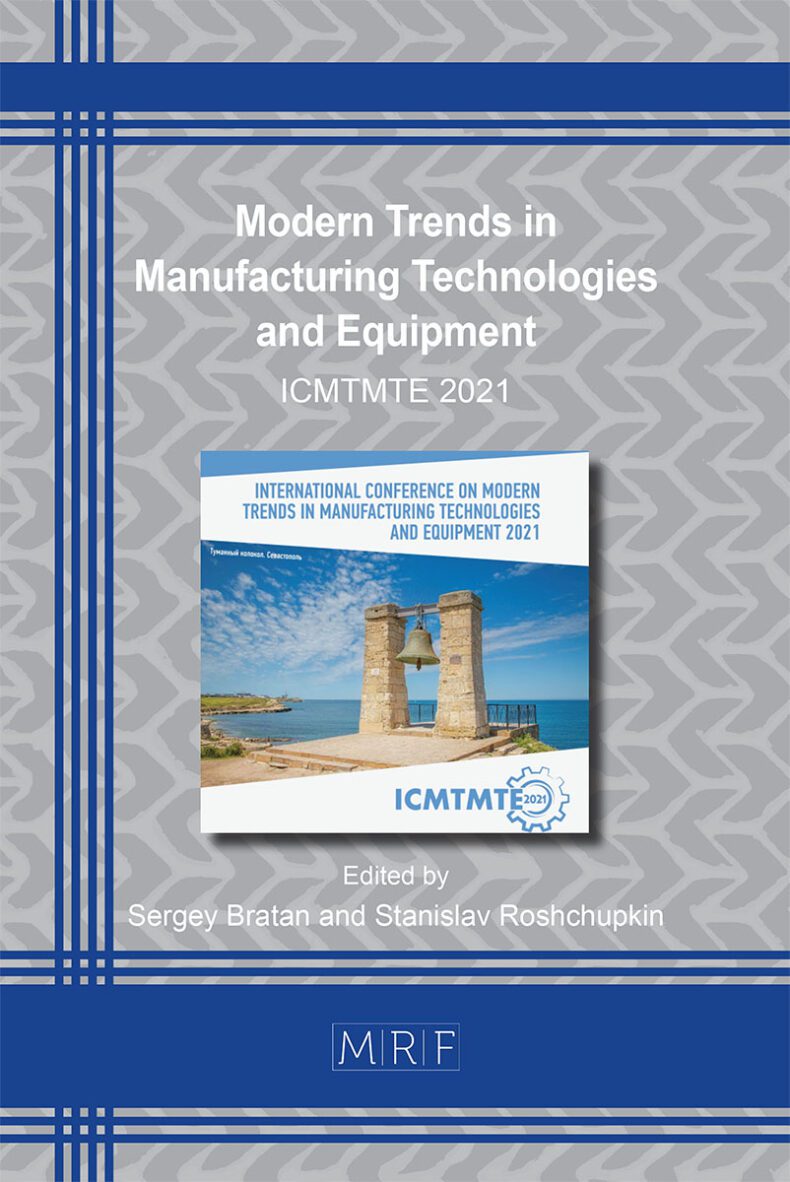Effect of UV-Irradiation and Ozone Exposure on Thermal and Mechanical Properties of PLA/LDPE Films
Maria Podzorova, Yulia Tertyshnaya, Anastasia Khramkova, Alina Ivanitskikh
download PDFAbstract. The mechanical properties of polymer composites based on polylactide vary significantly over a wide range of values. It has been established that photodegradation of low-density polyethylene – polylactide blends occurs both in the amorphous and in the crystalline phase of the PLA matrix, which leads to deterioration of the mechanical properties of the studied mixtures. Ozonolysis affects the strength parameters of polylactide-polyethylene samples as well as photodegradation. By the differential scanning calorimetry it is determined that the melting point of polylactide decreases by 2-4 °C, the glass transition temperature – by 1-3 °C, while the degree of crystallinity increases by 3-6%. In the process of ozonolysis, the thermophysical characteristics of PLA/LDPE have changed.
Keywords
Polyethylene, Polylactide, Films, Biodegradation, UV-Irradiationon
Published online 1/5/2022, 5 pages
Copyright © 2022 by the author(s)
Published under license by Materials Research Forum LLC., Millersville PA, USA
Citation: Maria Podzorova, Yulia Tertyshnaya, Anastasia Khramkova, Alina Ivanitskikh, Effect of UV-Irradiation and Ozone Exposure on Thermal and Mechanical Properties of PLA/LDPE Films, Materials Research Proceedings, Vol. 21, pp 76-80, 2022
DOI: https://doi.org/10.21741/9781644901755-14
The article was published as article 14 of the book Modern Trends in Manufacturing Technologies and Equipment
![]() Content from this work may be used under the terms of the Creative Commons Attribution 3.0 licence. Any further distribution of this work must maintain attribution to the author(s) and the title of the work, journal citation and DOI.
Content from this work may be used under the terms of the Creative Commons Attribution 3.0 licence. Any further distribution of this work must maintain attribution to the author(s) and the title of the work, journal citation and DOI.
References
[1] S. Farah, D.G. Anderson, R. Langer, Physical and mechanical properties of PLA, and their functions in widespread applications — A comprehensive review, Adv. Drug Deliv. Rev. 107 (2016) 367-392. https://doi.org/10.1016/j.addr.2016.06.012
[2] Y. Tertyshnaya, S. Karpova, M. Moskovskiy, A. Dorokhov, Electrospun polylactide/natural rubber fibers: effect natural rubber content on fiber morphology and properties, Polymers. 13 (2021) 2232. https://doi.org/10.3390/polym13142232
[3] M.P. Arrieta, J. Lopez, D. Lopez, J.M. Kenny, L. Peponi, Effect of chitosan and catechin addition on the structural, thermal, mechanical and disintegration properties of plasticized electrospun PLA-PHB biocomposites, Polym. Degrad. Stab. 132 (2016) 145-156. https://doi.org/10.1016/j.polymdegradstab.2016.02.027
[4] Y.V. Tertyshnaya, M.V. Podzorova, Composite materials based on polylactide and poly-3-hydroxybutyrate “Green” polymers, Russ. J. Appl. Chem. 91 (3) (2018) 417−423. https://doi.org/10.1134/S1070427218030126
[5] M.V. Podzorova, Yu.V. Tertyshnaya, S.G. Karpova, A.A. Popov, Impact of UV treatment on polylactide–polyethylene film properties, IOP Conf. Series: Materials Science and Engineering 525 (2019) 012043. https://doi.org/10.1088/1757-899X/525/1/012043
[6] E. Olewnik-Kruszkowska, I. Koter, J. Skopinska-Wisniewskab, J. Richert, Degradation of polylactide composites under UV irradiation at 254 nm, J. Photochem. Photobiol. A: Chemistry. 311 (2015) 144-153. https://doi.org/10.1016/j.jphotochem.2015.06.029
[7] A. Ashrafi, M. Jokar, N.A. Mohammadi, Preparation and characterization of biocomposite film based on chitosan and kombucha tea as active food packaging, Int. J. Biol. Macromol. 108 (2017) 444. https://doi.org/10.1016/j.ijbiomac.2017.12.028
[8] H. Wang, L. Wang, Developing a bio-based packaging film from soya by-products incorporated with valonea tannin, J. Clean. Prod. 143 (2017). https://doi.org/10.1016/j.jclepro.2016.12.064
[9] Y. Han, M. Yu, L. Wang, Bio-based films prepared with soybean by-products and pine (Pinus densiflora) bark extract, J. Clean. Prod. 187 (2018) 1–8. https://doi.org/10.1016/j.jclepro.2018.03.115
[10] H. J. Jeon, M.N. Kim, Biodegradation of poly(L-lactide) (PLA) exposed to UV irradiation by a mesophilic bacterium, Int. Biodeterior. Biodegrad. 85 (2013) 289-293. https://doi.org/10.1016/j.ibiod.2013.08.013
[11] M. V. Podzorova, Yu. V. Tertyshnaya, Degradation of polylactide—polyethylene binary blends in soil, Rus. J. Appl. Chem. 92 (6) (2019) 767-774. https://doi.org/10.1134/S1070427219060065
[12] L. Jiang, J. Zhang, M.P. Wolcott, Comparison of polylactide/nano-sized calcium carbonate and polylactide/montmorillonite composites: reinforcing effects and toughening mechanisms, Polymer. 48 (26) (2007) 7632-7644. https://doi.org/10.1016/j.polymer.2007.11.001
[13] B. Fayolle, E. Richaud, X. Colin, J. Verdu, Degradation-induced embrittlement in semi-crystalline polymers having their amorphous phase in rubbery state, J. Mater. Sci. 43 (22) (2008) 6999-7012. https://doi.org/10.1007/s10853-008-3005-3
[14] A. Fairbrother, H.-C. Hsueh, J. H. Kim, De. Jacobs, L. Perry, D. Goodwin, C. White, S. Watson, L.-P. Sung, Temperature and light intensity effects on photodegradation of high-density polyethylene, Polym. Degrad. Stab. 165 (2019) 153-160. https://doi.org/10.1016/j.polymdegradstab.2019.05.002
[15] Yu. V. Tertyshnaya, M. V. Podzorova, Effect of UV irradiation on the structural and dynamic characteristics of polylactide and its blends with polyethylene, Russ. J. Phys. Chem. B. 14 (1) (2020), 167–175. https://doi.org/10.1134/S1990793120010170
[16] L-T. Lim, R. Auras, M. Rubino, Processing technology for poly(lactic acid), Prog. Polym. Sci. 33 (2008) 820-852. https://doi.org/10.1016/j.progpolymsci.2008.05.004
[17] Q. Zhou, M. Xanthos, Nanoclay and crystallinity effects on the hydrolytic degradation of polylactides, Polym. Degrad. Stab. 93 (8) (2008) 1450-1459. https://doi.org/10.1016/j.polymdegradstab.2008.05.014
[18] R.O.F. Verkuijlen, M.H.A. van Dongen, A.A.E. Stevens, J. van Geldrop, J.P.C. Bernards, Surface modification of polycarbonate and polyethylene naphtalate foils by UV-ozone treatment and mu Plasma printing, Appl. Surf. Sci. 290 (2014). 381-387. https://doi.org/10.1016/j.apsusc.2013.11.089
[19] A. Mahfoudh, F. Poncin-Epaillard, M. Moisan, J. Barbeau, Effect of. dry-ozone exposure on different polymer surfaces and their resulting bio-. cidal action on sporulated bacteria, Surf. Sci. 604 (2010) 1487-1493. https://doi.org/10.1016/j.susc.2010.05.013
[20] A. Delplanque, E. Henry, J. Lautru, H. Leh, M. Buckle, C. Nogues, UV/ozone surface treatment increases hydrophilicity and enhances functionality of SU-8 photoresist polymer, Appl. Surf. Sci. 314 (2014) 280-285. https://doi.org/10.1016/j.apsusc.2014.06.053
[21] W. Yue, R. He, P. Yao, Y. Wei, Ultraviolet radiation-induced accelerated degradation of chitosan by ozone treatment, Carbohydr. Polym. 77 (2009) 639-642. https://doi.org/10.1016/j.carbpol.2009.02.015































